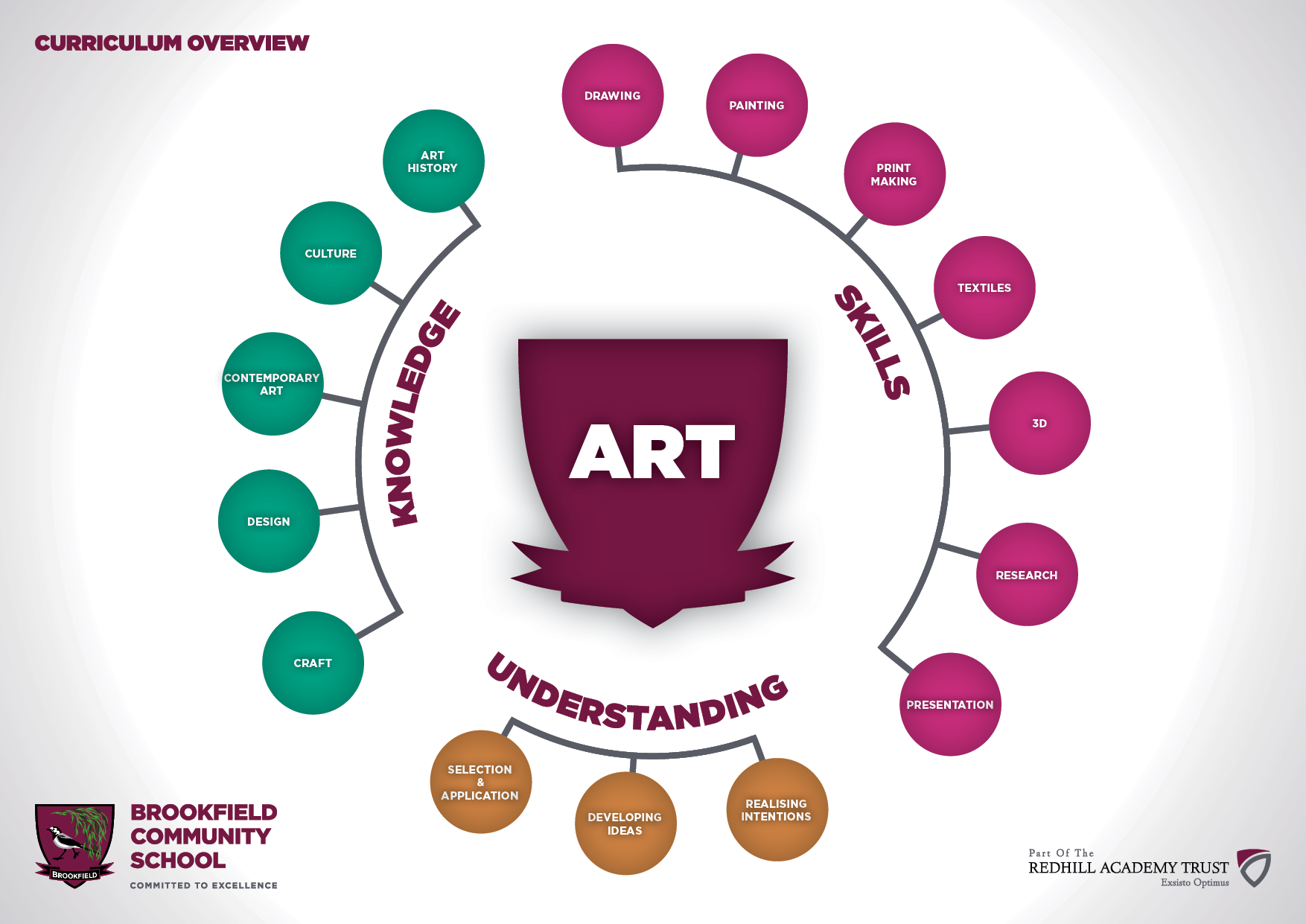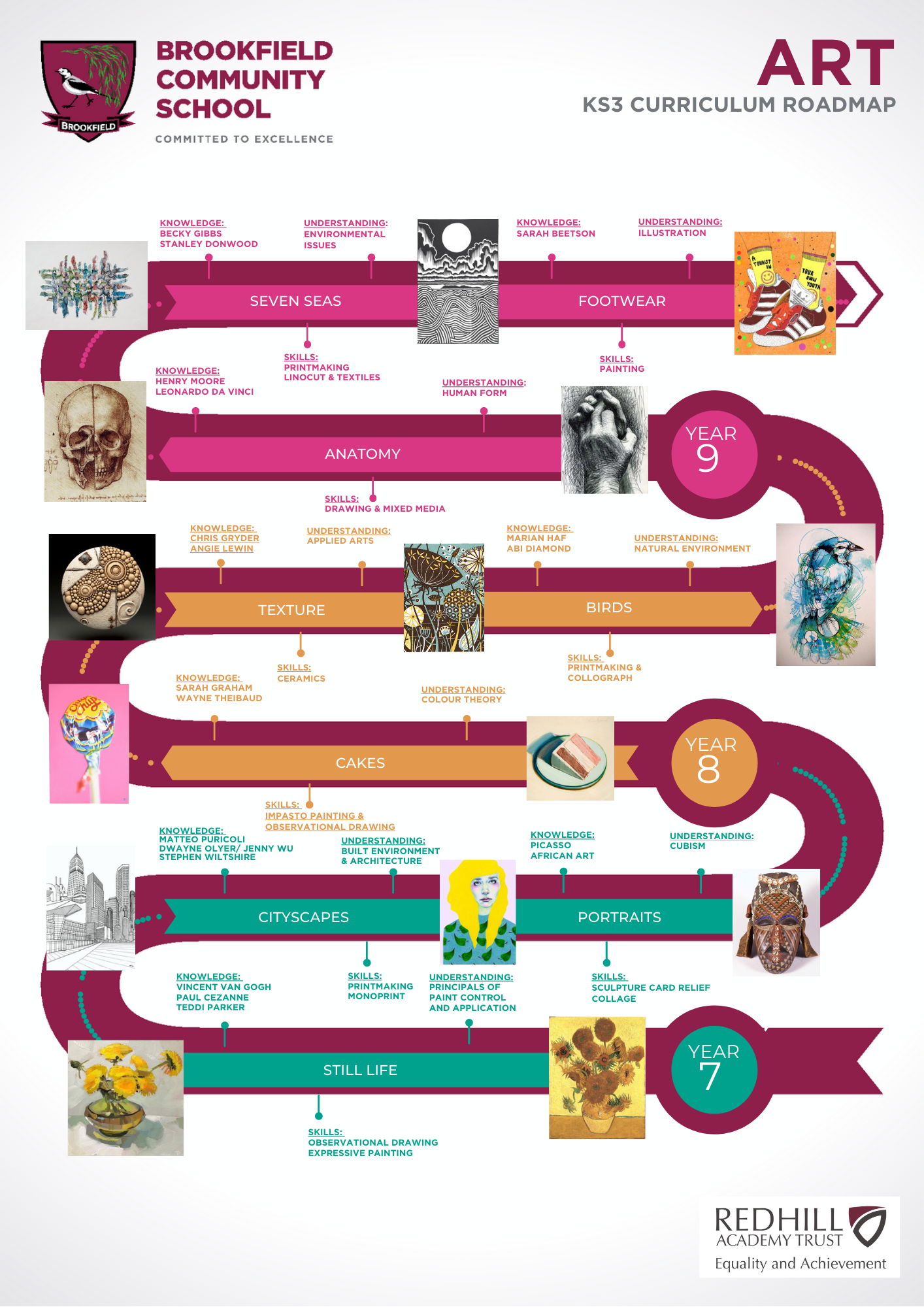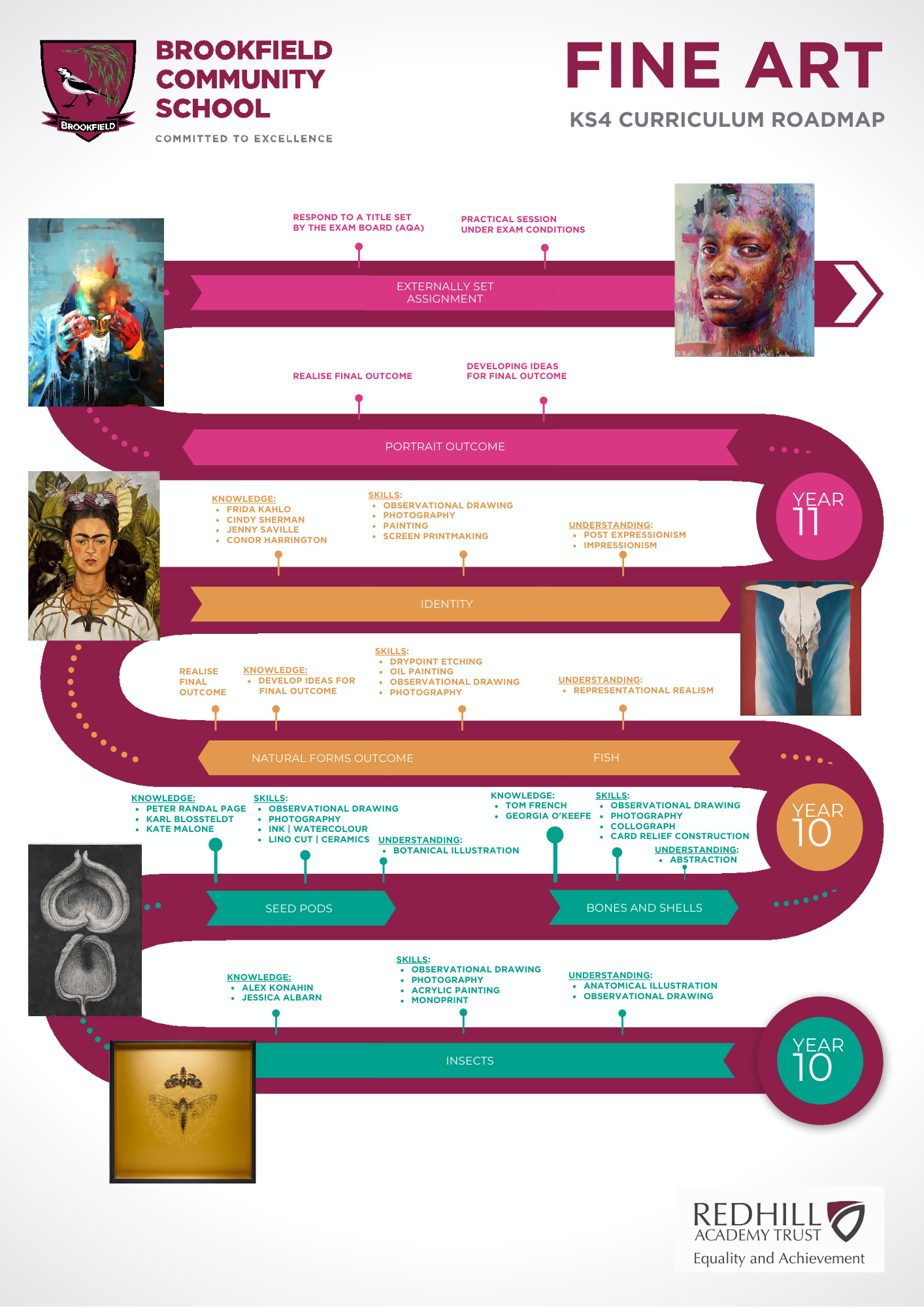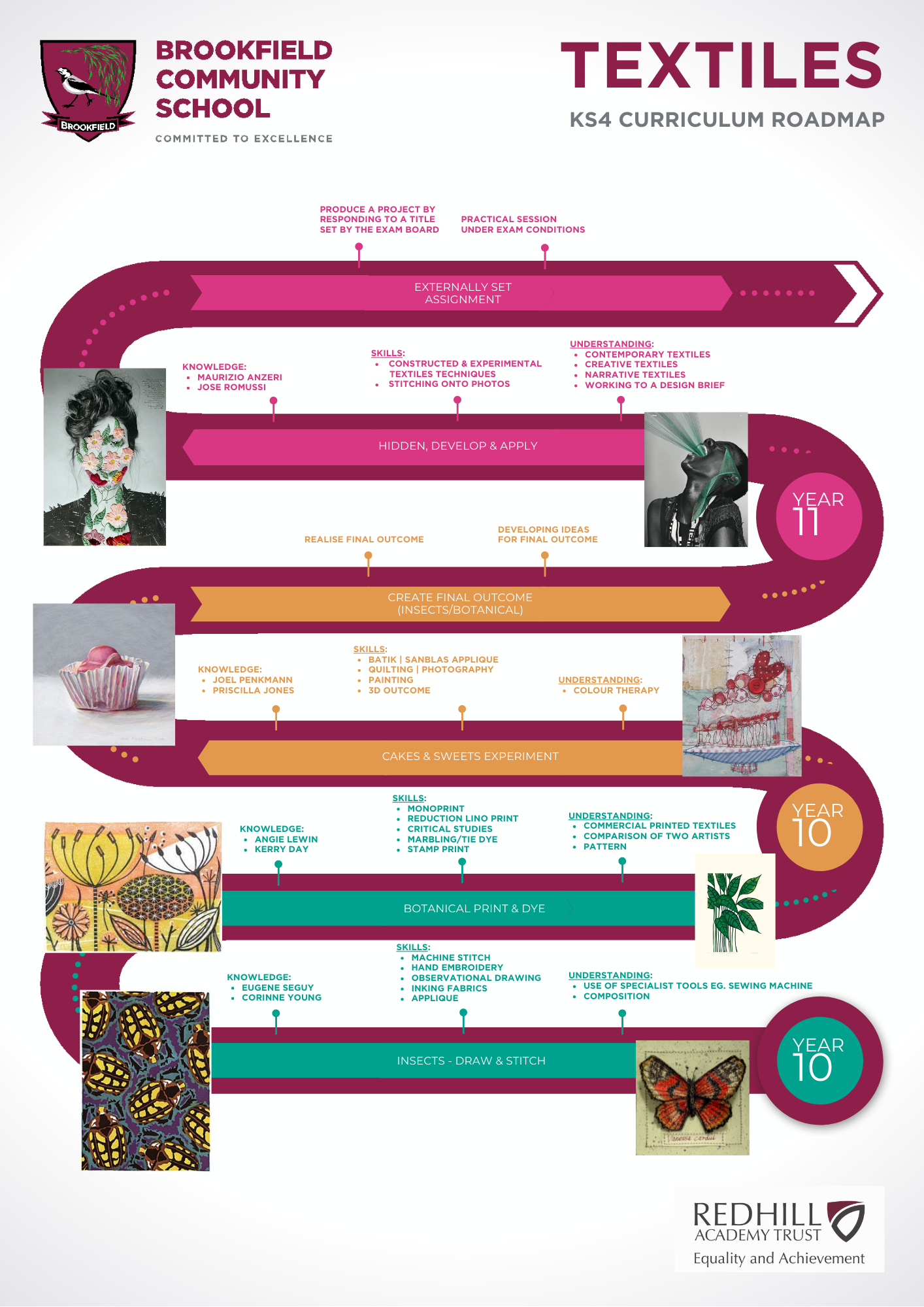Art
 Click image to view full size.
Click image to view full size.
Introduction to Art
The Art Department aims to inspire and educate our students, through an artistic curriculum that incorporates a broad spectrum of disciplines. Students develop practical skills through demonstration, participation and application. We study artists, artistic movements and cultures from wide and diverse cultural, historical and political contexts. Furthermore, we encourage students to combine technical proficiency with research to help the development of their own ideas and creative responses.
Key Stage 3
Key Stage 3 students have one Art lesson per week. Students are taught in mixed ability form groups.
Over the course of this key stage, we study drawing, painting, printmaking, photography, sculpture and textile art. We support students to visually research, observe, creatively develop ideas, think critically and operate safe studio practice.

Key Stage 4
GCSE Fine Art
GCSE Textiles
Exam Board: AQA
The Course
Students are introduced to a variety of artistic learning experiences, which encourage the development of skills through the use of media, processes, techniques and technologies.
Students are encouraged to progressively develop strengths and interests in the subject and, increasingly, follow their own lines of enquiry. Students will develop knowledge and understanding through sustained practical application of skills drawing on:
- the work and approaches of artists, craftspeople or designers from contemporary and historical periods and cultures.
- contemporary and/or historical environments, situations or issues.
- the ways in which meanings, ideas and intentions can be communicated through visual language.
- formal elements, including: colour, line, form, shape, tone and texture.
- the characteristics, properties and effects of using different media, materials, techniques and processes.
- the different purposes, intentions and functions of art, craft and design.
- apply an understanding of relevant practises in the creative and cultural industries to their work.
- refine their ideas as work progresses through experimenting with media, materials, techniques and processes.
- record their ideas, observations, insights and independent judgements, visually and through written annotation, using appropriate specialist vocabulary, as work progresses.
- effective and safe use of media, materials, techniques, processes and technologies.
- use drawing skills for different needs and purposes, appropriate to context.
- realise personal intentions through sustained application of the creative process.
How are students assessed?
Component 1: Portfolio
A portfolio is completed that in total shows explicit coverage of the four assessment objectives. It must include a sustained project evidencing the journey from initial engagement to the realisation of intentions and a selection of further work undertaken during the student’s course of study. This is no-exam assessment (NEA), is set and marked by the school and moderated by AQA during a visit. There are 96 marks available; this component will form 60% of the final GCSE grade.
Component 2: Externally Set Assignment
Students respond to their chosen starting point from an externally set assignment paper relating to their subject title, evidencing coverage of all four assessment objectives. Preparatory period followed by 10 hours of supervised time. This is on-exam assessment (NEA) set by AQA, marked by the school and moderated by AQA during a visit. There are 96 marks available, this competent forms 40% of the final GCSE grade.


Key Stage 5
A Level Fine Art
A Level Textiles
A Level Photography
Exam Board: AQA
The Course
Students are introduced to a variety of experiences that employ a range of traditional and new media, processes and techniques. Knowledge of art, craft and design is developed through research, the development of ideas and making, working from first-hand experience and, where appropriate, secondary source materials. Students are required to participate actively in their course of study, recognising and developing their own strengths in the subject and identifying and sustaining their own lines of enquiry.
We support students to develop practical and theoretical knowledge and understanding of:
- Relevant materials, processes, technologies and resources
- How ideas, feelings and meanings can be conveyed and interpreted in images and artefacts
- How images and artefacts relate to the time and place in which they were made and to their social and cultural contexts
- Continuity and change in different genres, styles and traditions
- A working vocabulary and specialist terminology.
We also support students to develop the skills to:
- Record experiences and observations, in a variety of ways using drawing or other appropriate visual forms; undertake research; and gather, select and organise visual and other appropriate information.
- Explore relevant resources; analyse, discuss and evaluate images, objects and artefacts and make and record independent judgements.
- Use knowledge and understanding of the work of others to develop and extend thinking and inform own work.
- Generate and explore potential lines of enquiry using appropriate media and techniques.
- Apply knowledge and understanding in making images and artefacts, review and modify work and plan and develop ideas in the light of their own and others’ evaluations.
- Organise, select and communicate ideas, solutions and responses, and present them in a range of visual forms.
How are students assessed?
Component 1: Personal Investigation
Students are required to conduct a practical investigation into an idea, issue, concept or theme, supported by written material. The focus of the investigation must be identified independently by the student and must lead to a finished outcome or a series of related finished outcomes. This is no-exam assessment (NEA), is set and marked by the school and moderated by AQA during a visit. There are 96 marks available, this component forms 60% of the final A Level grade.
Component 2: Externally Set Assignment
Students respond to their chosen starting point from an externally set assignment paper relating to their subject title, evidencing coverage of all four assessment objectives. Preparatory period followed by 10 hours of supervised time. This is on-exam assessment (NEA) set by and marked by the school and moderated by AQA during a visit. There are 96 marks available, this component forms 40% of the final A Level grade.
Enrichment
We offer a wide range of opportunities for students to be able to develop their learning outside their timetabled lessons.
- A Level: Open studio access in non-contact lessons, Residential Gallery visit to London, Life Drawing Millennium Gallery, Graduates Arts Fair, Cross-Endorsement Workshops, Illustration Collective, Set design for school production. Y13 Exhibition
- KS4: Two hours of co-curricular classroom access and teacher support per week. Y10 Yorkshire Sculpture Park and Hepworth Gallery visit. Y11 Exhibition
- KS3: Young Brookfield Artist Award.
Progression Opportunities
Students may go on to higher education and study a degree (Bachelor of Arts) a master’s degree (Masters of Art) and PhD (Doctor of Philosophy). Students could also go on to secure an apprenticeship in their chosen field.
Arts careers may be pursued in the following industries: architecture, fashion, photography, fine art, graphic design, illustration, gallery curation, art therapy, teaching, lecturing, art history, media, film and television, theatre, technical support, auctioneers, conservation and restoration, arts admin and organisation.

